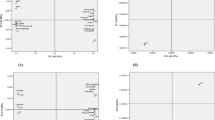Abstract
A number of physicochemical properties and mineral contents of seeds belonging to selected varieties of Citrus species were determined. While mean length values of mandarin seeds varied between 10.56 mm ‘Mineola’ and 11.80 mm ‘Klementin’, mean width values of mandarin seeds measured between 5.46 mm ‘Mineola’ and 5.97 mm ‘Klementin’. In addition, mean thickness and hull/seed values of mandarin seeds varied between 3.13 mm ‘Nova’ and 4.37 mm ‘Mineola’ and 0.23 mm ‘Nova’ and 0.38 mm ‘Fairchild’, respectively. Mean crude protein and oil contents of mandarin seeds were between 14.10% ‘Fremont’ and 17.63% ‘Mineola’ and 31.03% ‘Mineola’ and 42.59% ‘Nova’, respectively. Also, mean crude fibre contents of mandarin seeds ranged from 13.55 ‘Nova’ and 20.02% ‘Mineola’. Mandarin seeds contained 3.82 ‘Nova’ to 5.67% ‘Fairchild’ galactose, 4.74 ‘Klementin’ to 7.24% sacharose ‘Fairchild’, 5.49 ‘Klementin’ to 7.20% stachyose ‘Fairchild’, 4.51 ‘Nova’ to 6.56% raffinose ‘Fairchild’, 5.30 ‘Nova’ to 9.48% fructose ‘Fairchild’ and 5.04 ‘Klementin’ to 7.64% glucose ‘Fairchild’ as mean values. The mean calcium content of orange seeds varied between 451.60 ‘Barile’ and 2739.30 mg/kg ‘Kozan Yerli’. In addition, the magnesium content of orange varied from 886.00 ‘Pineapple’ to 1708.00 mg/kg ‘Kan’. Also, phosphorus contents of orange seeds were between 2443 ‘Barile’ and 3939 mg/kg ‘Kan’.

Similar content being viewed by others
References
Abdel-Rahman AY (1980) A study on some Egyption Citrus seed oils. Grasas Aceites 31(5):331–333
Aitzetmüller K (1993) Capillary GLC fatty acid fingerprints of seed lipids—A tool in plant chemotaxonomy. J High Resolut Chromatogr 16:488–490
Ajewole K, Adeyeye A (1993) Characterisation of Nigerian Citrus seed oils. Food Chem 47(1):77–78
Akpata MI, Akubor PI (1999) Chemical composition and selected functional properties of sweet orange (Citrus sinensis) seed flour. Plant Foods Hum Nutr 54:353–362
AlJuhaimi F, Matthäus B, Özcan MM, Ghafoor K (2016) The physico-chemical properties of some Citrus seeds and seed oils. Z Naturforsch 71(3–4):79–85
Anwar F, Naseer R, Bhanger MI, Ashraf S, Talpur FN, Aladedunye FA (2008) Physico-chemical characteristics of Citrus seeds and seed oils from Pakistan. J Am Oil Chem Soc 85:321–330
AOAC (2000) Official methods of analysis, 17th edn. Association of Official Analytical Chemists, Gaithersburg
Duman E, Soltanbeigi A, Özcan MM (2016) Chemical composition of essential oil of some Citrus spp. (sour, lemon, kamkuat, mandarin and orange) peels. Z Arznei Gewurzpflanz 21:153–159
El-Adawy TA, Rahma EH, El-Bedawy AA, Gafar AM (1999) Properties of some Citrus seeds. Part 3. Evaluation as a new source of protein and oil. Food/Nahrung 43:385–391
El-Safy FS, Salem RH, Abd El-Ghany ME (2012) Chemical and nutritional evaluation of different seed flours as novel sources of protein. World J Dairy Food Sci 7(1):59–65
Giannoccaro E, Wang Y‑J, Chen PC (1992) Effect of solvent, temperature, time, solvent-to-sample ratio, sample size and defatting on the extraction of soluble sugars in soybean. J Food Sci 71(1):59–64
Greenfield H, Southgate DAT (1992) Food composition data, production, management and use. Elsevier, London
Gültekin Ö, Özcan MM, Aljuhaimi F (2016) Some physicochemical properties, fatty acid composition, and tocopherol contents of Citrus seed oils. Riv Ital Sostanze Grasse XCIII:47–51
Habib MA, Hammam MA, Sakr AA, Ashoush YA (1986) Chemical evaluation of Egyptian citrus seeds as potential sources of vegetable oils. J Am Oil Chem Soc 63:1192–1196
İnan Ö, Özcan MM, Aljuhaimi F (2018) Effect of location and Citrus species on total phenolic, antioxidant, and radical scavenging activities of some Citrus seed and oils. J Food Process Preserv 42(3):1–6
Kamel BS, Demna JM, Blackman B (1982) Nutritional, fatty acid and oil characteristics of different agricultural seeds. J Food Technol 17:263–269
Konarski P, Haluszka J, C’Wil M (2006) Comparison of urban and rural particulate air pollution characteristics obtained by SIMS and SSMS. Appl Surface Sci 252:7010–7013
Lazos ES, Servos DC (1988) Nutritional and chemical characteristics of orange seed oil. Grasas Aceites 39:232–234
Matthaus B, Özcan MM (2012) Chemical evaluation of citrus seeds, an agro-industrial waste, as a new potential source of vegetable oils. Grasas Aceites 63:313–320
Okoye COB, Ibeto CN, Ihedioha JN (2011) Preliminary studies on the characterization of orange seed and pawpaw seed oils. Am J Food Technol 6:422–426
Özcan MM, İnan Ö (2022) Physico-chemical properties, fatty acid composition and tocopherol contents of mandarin, orange and lemon seed oils. Erwerbs Obstbau. https://doi.org/10.1007/s10341-022-00648-z (in press)
Özcan MM, Ghafoor K, AlJuhaim F, Uslu N, Babiker EE, Ahmed IMA, Almusallam IA (2021) Influence of drying techniques on bioactive properties, phenolic compounds and fatty acid compositions of dried lemon and orange peel powders. J Food Sci Technol 58(1):147–158
Pena DG, Anguiano RGL, Arredondo JJM (1992) Modification of the method 1 AOAC (CB method) for the detection of aflatoxins. Bull Environ Contam Toxicol 49:485–489
Püskülcü H, Ikiz F (1989) Introduction to statistic. Bilgehan, Bornova, p 333 (in Turkish)
Reda SY, Leal ES, Batista EAC (2005) Characterization of rangpur lime (Citrus limonia Osbeck) and “sicilian” lemon (Citrus limon) seed oils, an agroindustrial waste. Cienc Tecnol Aliment 25:672–676
Saidani M, Dhifi W, Marzouk BJ (2004) Lipid evaluation of some Tunisian Citrus seeds. Food Lipids 11:242–250
Schieber A, Stintzing FC, Carle R (2001) By-products of plant food processing as a source of functional compounds-recent developments. Trends Food Sci Technol 12(11):401–413
Skujins S (1998) Handbook for ICP-AES (Varian-vista). A hort guide to vista series ICP-AES operation. Varian, Zug, p 29 (Version 1.0)
Author information
Authors and Affiliations
Corresponding author
Ethics declarations
Conflict of interest
M.M. Özcan and Ö. İnan declare that they have no competing interests.
Rights and permissions
About this article
Cite this article
Özcan, M.M., İnan, Ö. Physicochemical Properties and Nutrition Element Contents of Citrus Seeds and Agroindustrial Waste. Erwerbs-Obstbau 65, 133–142 (2023). https://doi.org/10.1007/s10341-022-00690-x
Received:
Accepted:
Published:
Issue Date:
DOI: https://doi.org/10.1007/s10341-022-00690-x




